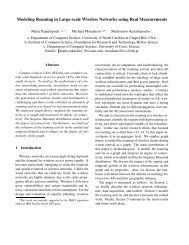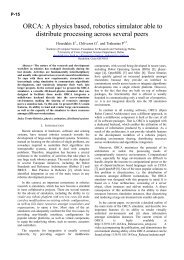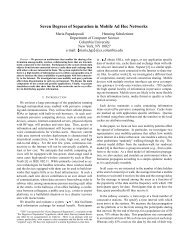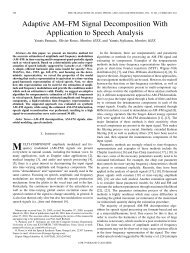Master Thesis - ICS
Master Thesis - ICS
Master Thesis - ICS
Create successful ePaper yourself
Turn your PDF publications into a flip-book with our unique Google optimized e-Paper software.
Computer Science Department<br />
Antonis Misargopoulos<br />
As such, the result of joining two relations is a subset, proper or otherwise, of the<br />
Cartesian product of the two relations. The tuples of either relation that do not participate<br />
in the join are called dangling tuples [108]. The result of joining relations R and S with n<br />
and m attributes, respectively, is a relation Q with n+m attributes. The relation Q has one<br />
tuple for each pair of tuples from R and S that satisfies the join condition. The result<br />
relation Q may then be defined as<br />
Q = { t | t = rs ∧ r ∈ R ∧ s ∈ S ∧ t(<br />
a)<br />
ϑt(<br />
b)}<br />
.<br />
The join operator is time-consuming and data-intensive operations. In the most<br />
naive implementation, each tuple in one relation must be compared to every tuple in the<br />
other relation. Therefore, the complexity of the operation for relations with n tuples each<br />
is Ο ( n<br />
2 ) . Further, the comparison of tuples requires a large number of I/O operations.<br />
Many algorithms have been devised to execute joins intending to reduce the number of<br />
comparisons, reduce the amount of I/O, or both.<br />
4.2 Types of Join<br />
Several other types of joins have been defined. Some are direct derivatives of the thetajoin;<br />
others are combinations of the theta-join and other relational operations such as<br />
projection. Some have been implemented as primitive operations in database<br />
management systems, whereas others are currently found only in the database literature.<br />
Variations of the join operation seen in database management systems and in the<br />
literature are discussed below.<br />
• Equi-Join<br />
The most commonly used theta operator is the equality operator; in these cases, the join is<br />
called an equi-join. For all other theta operators the join is called a non equi-join. The<br />
result relation Q is defined as follows:<br />
36

















